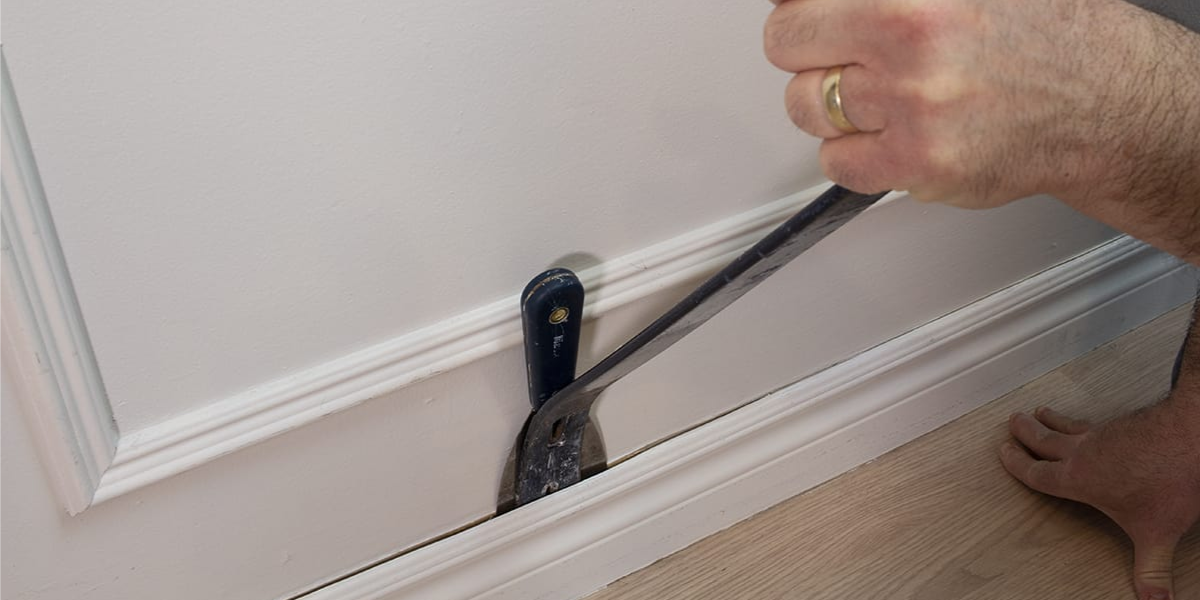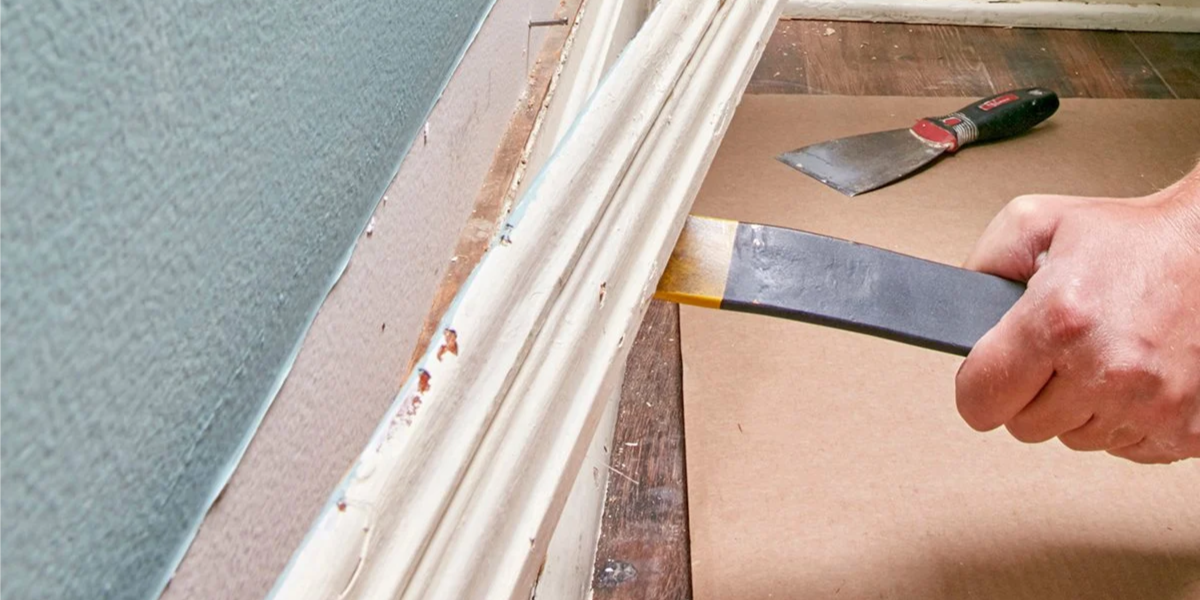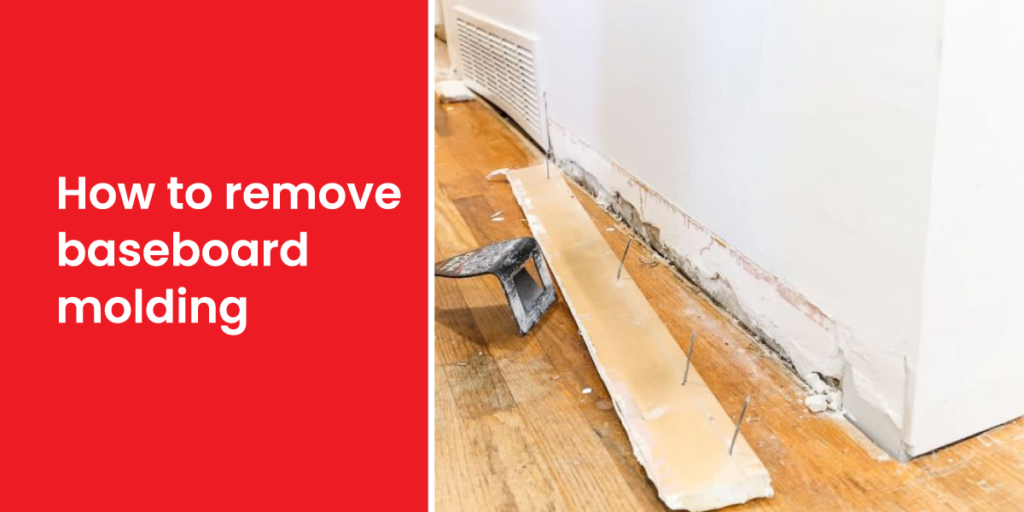Baseboard moldings need to be removed for various reasons, from installing new ones to repairing any water damage to the floor or the drywall. This is the reason you must know how to remove baseboard molding. You will first need to loosen the baseboard with a knife and remove the nails. Next, you need to pry the baseboard off and then clean underneath.
The baseboard is an essential part of your home and plays an important role in not only its aesthetics, but its functionality as well. There are a plethora of reasons these baseboard and their moldings need to be removed. Be it renovation of the house, repairing water damage, or settling various cracks and other damages, you will need to remove the baseboard moldings.
Let’s take a look at the process of removing baseboard molding.
How to remove baseboard trim

While you remove baseboards, you have to keep in mind that the work will not be done as soon as you score the trimmings off with a knife. Removing the baseboard moldings is an elaborate process, and you have to be very careful since you will be dealing with sharp objects. Speaking of which, here are the materials you will need for removing the baseboard molding.
- A Utility Knife
- Hammer
- Pliers
- Rubber Gloves
- Pry Bar/Putty Knife
Now, here is how to remove baseboards
- Breaking the caulk line: First, take the utility knife, and score along the caulk line with it. Ensure you score along the entire line where the wall and baseboard meet. Doing this will ensure that the drywall will not be damaged when you remove the baseboard. Otherwise, you run the risk of tearing the drywall.
- Locating the nails: There are a lot of nails that secure the baseboard to the floor. After scoring the caulk line, you have to locate these nails in order to pry them off the floor. You can either use your eyes or a stud finder to locate them.
- Loosening the Baseboard: Once you are done locating the nails, you will then need to loosen the baseboards. You can either gently use a putty knife or a pry bar behind the baseboard. This will loosen the baseboards without harming the drywall. If needed, tap the baseboard with a hammer.
Next, keep working very slowly and gently along the length of the baseboard to loosen the baseboard molding. Don’t rush, or you will damage either the drywall or the baseboard, or even both of them.
- Prying the baseboard off: Once you have loosened the baseboard enough, you can now pry the baseboard off. The pry bar will now come in handy, as you use it to pry the baseboards from the floor. Start at one end of the board, and gently pry it away from the wall.
- Removing the nails: Now you can remove the nails you had located before. This part is comparatively very easy, as you can use pliers or the claw of the hammer to do so. Once you are done, use your hands or a stud finder to see if you have missed anything.
- Cleaning Up: After you are done removing the baseboard molding and the nails, you need to finish up by cleaning. After removing the nails and moldings, you will notice some residual adhesive and/or caulking on the floor and the wall. Scrape every bit of residue with a suitable tool to finish the removal process.
Why do you need to remove baseboard molding?

Now that you know how to take off baseboards, here is why you need to do it.
- Water Damage: Water damage is one of the main reasons baseboards need to be taken off and replaced. When water gets into the floors due to flooding or leaks, it keeps damaging the floorboards over time, and hence, the removal is required.
- Renovation: Another chief reason for removing baseboard molding is renovating the house. While renovating, you sometimes need to tear off the drywall or install new baseboards. This is why you need to remove the baseboard moldings.
- Damage: Water damage is not the only type of damage your baseboards suffer. They can also suffer damages due to wear and tear, cracks, dents, or even their paint can be irreparably damaged. When this happens, you will need to remove the baseboards and baseboard trimmings have to be removed.
- Pest: Baseboards are some of the favorite places for pests like rats to nest in. When this happens, you must remove the baseboards to get rid of them. And if the pests have damaged the baseboards as well, you need to replace the entire baseboard.
- House Settling: Sometimes, cracks or gaps can appear along the line of the wall. This can unsettle the balance of your home. To restore balance and settle the house, you will need to take off the baseboard and reinstall it.
Final Thoughts
Knowing how to remove baseboard molding is very important, but knowing whether you can do the job yourself is equally important. Since you have to work with sharp objects and the work itself is pretty delicate, you can contact us to take care of it for you. We have all the professional expertise and the tools to remove your baseboard molding with no further damage.
FAQ
1. What is the easiest way to remove baseboards?
The easiest way to remove baseboards is to loosen the baseboard using the utility knife, pry the baseboard off with a pry bar, and remove all the nails with the claw of the hammer. You must always wear protective gear while doing so.
2. What is the best tool to remove baseboards?
The best tools to remove baseboards are as follows
- Utility knife
- Stud Finder
- Pry Bar/Putty Knife
- Hammer
- Gloves for protection
3. Is removing baseboards hard?
Whether removing baseboards is hard or not depends on the expertise, experience, and the availability of the required tools. If someone has enough experience, expertise, and the right tools, then removing baseboards is not too difficult. On the other hand, in inexperienced hands, baseboard removal can be one of the hardest and messiest of any household jobs.
4. How to remove molding without damaging it?
To remove baseboard molding without damaging it, you need to follow the following tips and tricks:
- Work gently and slowly to avoid damaging the drywall and/or the baseboards
- Use the correct tools for the work
- Label each baseboard so that reinstalling them is easier.
- Use a thin cardboard behind the pry bar so that the boards aren’t damaged.
5. Do you have to remove baseboards to install vinyl flooring?
You don’t actually HAVE TO remove your baseboards while installing vinyl flooring, but we recommend you do so. This way, you can avoid damaging the baseboards and the flooring along with the drywall.
Meta Description: Remove your baseboard molding with a utility knife, pry bar, hammer, and gloves. Work gently and slowly to avoid damage.

